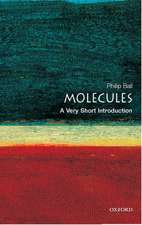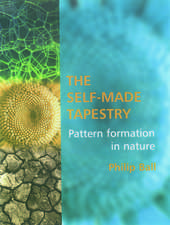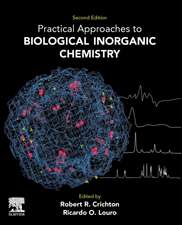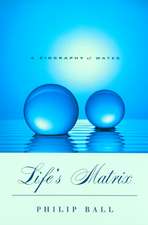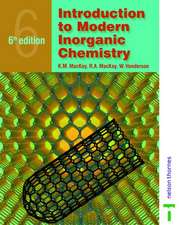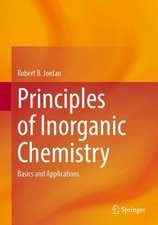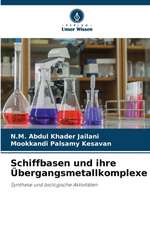The Elements: A Very Short Introduction: Very Short Introductions
Autor Philip Ballen Limba Engleză Paperback – 8 apr 2004
This Very Short Introduction traces the history and cultural impact of the elements on humankind, and examines why people have long sought to identify the substances around them. Looking beyond the Periodic Table, the author examines our relationship with matter, from the uncomplicated vision of the Greek philosophers, who believed there were four elements - earth, air, fire, and water - to the work of modern-day scientists in creating elements such as hassium andmeitnerium. Packed with anecdotes, The Elements is a highly engaging and entertaining exploration of the fundamental question: what is the world made from? ABOUT THE SERIES: The Very Short Introductions series from Oxford University Press contains hundreds of titles in almost every subject area. These pocket-sized books are the perfect way to get ahead in a new subject quickly. Our expert authors combine facts, analysis, perspective, new ideas, and enthusiasm to make interesting and challenging topics highly readable.
| Toate formatele și edițiile | Preț | Express |
|---|---|---|
| Paperback (1) | 52.16 lei 10-16 zile | +17.40 lei 5-11 zile |
| Oxford University Press – 8 apr 2004 | 52.16 lei 10-16 zile | +17.40 lei 5-11 zile |
| Hardback (2) | 142.18 lei 3-5 săpt. | +76.76 lei 5-11 zile |
| Thames & Hudson – 8 sep 2021 | 142.18 lei 3-5 săpt. | +76.76 lei 5-11 zile |
| University of Chicago Press – 27 sep 2021 | 240.65 lei 3-5 săpt. |
Din seria Very Short Introductions
-
 Preț: 47.20 lei
Preț: 47.20 lei -
 Preț: 47.01 lei
Preț: 47.01 lei -
 Preț: 40.95 lei
Preț: 40.95 lei -
 Preț: 46.09 lei
Preț: 46.09 lei - 5%
 Preț: 56.93 lei
Preț: 56.93 lei -
 Preț: 56.45 lei
Preț: 56.45 lei -
 Preț: 56.93 lei
Preț: 56.93 lei -
 Preț: 46.72 lei
Preț: 46.72 lei - 17%
 Preț: 51.73 lei
Preț: 51.73 lei - 18%
 Preț: 51.45 lei
Preț: 51.45 lei - 18%
 Preț: 51.54 lei
Preț: 51.54 lei - 17%
 Preț: 51.82 lei
Preț: 51.82 lei - 17%
 Preț: 52.08 lei
Preț: 52.08 lei - 17%
 Preț: 51.99 lei
Preț: 51.99 lei - 17%
 Preț: 52.16 lei
Preț: 52.16 lei - 17%
 Preț: 52.11 lei
Preț: 52.11 lei - 17%
 Preț: 51.73 lei
Preț: 51.73 lei - 18%
 Preț: 51.45 lei
Preț: 51.45 lei - 17%
 Preț: 52.26 lei
Preț: 52.26 lei - 17%
 Preț: 51.91 lei
Preț: 51.91 lei - 17%
 Preț: 51.73 lei
Preț: 51.73 lei - 18%
 Preț: 50.75 lei
Preț: 50.75 lei - 17%
 Preț: 51.82 lei
Preț: 51.82 lei - 18%
 Preț: 51.19 lei
Preț: 51.19 lei - 17%
 Preț: 51.63 lei
Preț: 51.63 lei - 30%
 Preț: 43.88 lei
Preț: 43.88 lei - 17%
 Preț: 51.63 lei
Preț: 51.63 lei -
 Preț: 67.80 lei
Preț: 67.80 lei - 17%
 Preț: 51.63 lei
Preț: 51.63 lei - 17%
 Preț: 51.91 lei
Preț: 51.91 lei - 17%
 Preț: 51.63 lei
Preț: 51.63 lei - 17%
 Preț: 51.82 lei
Preț: 51.82 lei - 17%
 Preț: 51.73 lei
Preț: 51.73 lei - 18%
 Preț: 51.28 lei
Preț: 51.28 lei - 17%
 Preț: 51.63 lei
Preț: 51.63 lei - 17%
 Preț: 51.63 lei
Preț: 51.63 lei - 17%
 Preț: 52.16 lei
Preț: 52.16 lei - 18%
 Preț: 51.28 lei
Preț: 51.28 lei - 18%
 Preț: 51.00 lei
Preț: 51.00 lei - 17%
 Preț: 52.08 lei
Preț: 52.08 lei - 18%
 Preț: 51.00 lei
Preț: 51.00 lei - 18%
 Preț: 51.45 lei
Preț: 51.45 lei - 17%
 Preț: 51.82 lei
Preț: 51.82 lei - 17%
 Preț: 52.16 lei
Preț: 52.16 lei - 17%
 Preț: 51.91 lei
Preț: 51.91 lei - 17%
 Preț: 52.08 lei
Preț: 52.08 lei - 17%
 Preț: 52.43 lei
Preț: 52.43 lei - 17%
 Preț: 52.26 lei
Preț: 52.26 lei - 17%
 Preț: 51.63 lei
Preț: 51.63 lei
Preț: 52.16 lei
Preț vechi: 62.85 lei
-17% Nou
9.98€ • 10.36$ • 8.32£
Carte disponibilă
Livrare economică 20-26 februarie
Livrare express 15-21 februarie pentru 27.39 lei
Specificații
ISBN-10: 0192840991
Pagini: 192
Ilustrații: numerous halftones & line drawings
Dimensiuni: 112 x 174 x 12 mm
Greutate: 0.16 kg
Editura: Oxford University Press
Colecția OUP Oxford
Seria Very Short Introductions
Locul publicării:Oxford, United Kingdom
Recenzii
A delight of a book.... Elegantly written...it's far-reaching, entertaining and salted with anecdote.... It could become a classic. Hold on to your first edition
engaging tour of the chemical elements
Philip Ball's book is an excellent introduction. I would have loved the book as an enthusiastic sixteen year-old and I would recommend it as a Christmas present to anyone at that age, and to journalists who may occasionally wish to appear smarter than they actually are.
a series of invigorating dips
Ball's choices are sound, his style is attractive
Ball brings the periodic table to life
A beautifully written and elegantly illustrated synthesis of chemistry and culture. Popularization of science at its very best.
Notă biografică
Philip Ball is a science writer and a consultant editor for Nature, where he was formerly an editor for physical science for over 10 years. He writes about all areas of science for the international press, and has broadcast on TV and radio. His previous books include Designing the Molecular World, The Self-Made Tapestry, H20: A Biography of Water, and Stories of the Invisible: A guided tour of molecules. He holds a degree inchemistry from Oxford University and a doctorate in physics from Bristol University. He lives in London, where his Homunculus Theatre Company occasionally performs on a shoestring budget.
Extras
All the same, it’s a dauntingly long list for new students of chemistry. They might have already heard of elements like carbon and oxygen, but scandium? Praesodymium? Even pronouncing the names of some of these elements can be a challenge, let alone remembering anything about them or finding the motivation to do so.
That’s where history might help. The elements were discovered only very gradually over time—from about 1730, at a surprisingly steady rate of about one every two or three years, with occasional bursts or hiatuses. This happened through no concerted program of seeking (at least not until the past several decades, when any newly discovered elements have had to be deliberately human-made). It was a haphazard business: scientists and technologists might find a previously unknown element in an obscure mineral, say, or by splitting sunlight into a spectrum to seek a telltale gap where some new element has stripped a color from it, or by liquefying and distilling air to find tiny quantities of rare gases. These tales of discovery are like biographies, and they can make the elements seem less like a random collection of obscure nobodies and more like characters in the long and continuing saga of how we have tried to comprehend and manipulate our surroundings. To chemists, they genuinely come to acquire personalities: helpful or recalcitrant, intriguing or dull, friendly or hazardous. That chemists regularly conduct polls of their “favorite elements” can seem unutterably nerdy—until you get to know the elements yourself, in which case you will almost certainly find that you have developed preferences and aversions of your own.
Some elements have proved immensely useful: as crucial ingredients in drugs or other medical agents, for example, or for making new materials that are harder, stronger, shinier, better conductors of electricity, and so on. Some have brightly colored compounds (combinations with other elements) that are valuable as pigments and dyes. Some are sources of energy, or essential nutrients for health, or refrigerants that can keep things colder than deep space. Their properties and uses have even elevated a few elements to privileged inclusion in the cultural lexicon: opportunities are golden, clouds have silver linings, suggestions go down like lead balloons, opponents are crushed with an iron fist, provocateurs are denied the oxygen of publicity. We might speak of the sodium glare of streetlights, of hydrogen bombs, of nickel-and-dime stores, magnesium flares, with little if any understanding of why those particular elements are being invoked. The very notion of an “element” itself connotes a fundamental principle beyond chemistry, for we speak of the elements of law, of mathematics (the topic of the ancient Greek thinker Euclid’s treatise The Elements), of language, of cookery.
All this implies that charting the history of the discovery of the chemical elements is more than an account of the development of chemistry as a science. It also offers us a view of how we have come to understand the natural world, including our own constitution. Furthermore, it shows how this knowledge has accompanied the evolution of our technologies and crafts—and “accompany” is the right word to use, because this narrative challenges the common but inaccurate view that science always moves from discovery to application. Often it is the reverse: practical concerns (such as mining or manufacturing) generate questions and challenges that lead to fresh discoveries. We can see too how scientific discovery is not some impersonal and inexorable process, but depends instead on the motivations, capabilities, and sometimes the idiosyncrasies of individual people: it requires determination, imagination, and ambition as well as insight and—never underestimate this—a substantial dash of good luck.
It’s an unavoidable fact that histories of this kind must dwell, especially in the past several centuries, to a degree that we now rightly find uncomfortable, on the exploits and achievements of men of European heritage. Not only was it very difficult until recent times for women to gain entry into scientific institutions, but even those few who did often faced intense discrimination and prejudice. Marie Curie, for example, who did most of the work in finding the elements radium and polonium at the end of the nineteenth century, was nearly overlooked when the work was rewarded by the 1903 Nobel Prize for Physics. Initially, the award was going to acknowledge only her husband and collaborator Pierre, before, forewarned, he objected. Similarly, Marie-Anne Paulze Lavoisier’s contributions to the work of her husband, the eminent eighteenth-century French chemist Antoine Lavoisier, were long considered little more than wifely duties rather than those of a scientific collaborator. Even as late as the 1950s, the American nuclear chemist Darleane Hoffman, who made vital contributions to the discoveries of new, heavy radioactive elements, was told when she arrived at Los Alamos National Laboratory to lead a new team that there must be some mistake because “We don’t hire women in that division.”
Why, meanwhile, people of color feature rather little in this story is a question fraught with the entire history of Western global dominance and exploitation since early modern times, as well as the prejudices and systematic biases that still lead to their under-representation in the sciences today. It isn’t clear for how much longer the story of element discovery will or, for that matter, can continue—but the rise of scientific excellence in Asia, at least, might lead us to expect as well as to hope that, if it does, then it will feature significantly more cultural richness and diversity.
Cuprins
The Periodic Table
Chapter 1. The Classical Elements
Chapter 2. The Antique Metals
Chapter 3. Alchemical Elements
Interlude: What Exactly Is an Element?
Chapter 4. The New Metals
Chapter 5. Chemistry’s Golden Age
Interlude: John Dalton’s Atoms
Chapter 6. Electrical Discoveries
Interlude: The Periodic Table
Chapter 7. The Radiant Age
Chapter 8. The Nuclear Age
Sources for Quotes
Further Reading
Index
Picture Credits


